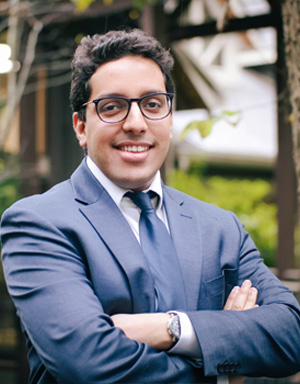Year-end Portfolio Checkup
The end of the year is approaching and the timing feels better now than ever to evaluate your overall savings and portfolio, and determine if you can increase what you are putting away for retirement. Join us as we discuss further and touch on important aspects to consider.
About The Speakers
 Moustapha Mounah, CFA, ERP
Moustapha Mounah, CFA, ERP
Assistant Portfolio Manager & Research Analyst, Investment Committee Member
 Neil Craft
Neil Craft
Client Relationship Manager
Moustapha Mounah: Doing very well. How are you?
Neil Craft: I'm good. I'm good. Thank you so much for taking the time to be with us today, and I'm very excited to get into today's podcast and share this great content with our listeners.
The end of the year is approaching and the timing feels better now than ever to really get into a yearly portfolio checkup. That's what Moustapha is here to discuss with us today. Now we'll say at the beginning, this list is not necessarily all encompassing, but our hope is to get investors at least thinking about a few common techniques that they can prepare for the end of the year.
So Moustapha, I think it might make sense to simply start with retirement savings, and you can take this in any direction you'd like.
Moustapha Mounah: Well the end of the year is a great time to evaluate your overall savings and performance portfolio, and determine if you can increase what you are putting away for retirement. Contribution to tax deferred retirement accounts, such as 401k’s can reduce your taxable income and provide tax deferred growth after retirement.
For 2021, the maximum employee contribution is $19,500, and if you are at the age of 50 or older, you qualify for a catch-up contribution, which allows you to add a $6,500 more to your 401k, for a total of $26,000.
Neil Craft: The catch-up contribution is very beneficial for investors in the asset accumulation phase, and for folks in their fifties and above.
Now, for that a catch up contribution, is that available for IRAs as well?
Moustapha Mounah: Yes, yes if the investor has the means to do so, this is another way to increase annual retirement savings for 2021. The maximum contribution is 6,000 for an IRA. The catch-up contribution, it's an extra thousand you are allowed for a total of a $7,000 contribution.
Neil Craft: Okay. Well, anything we can do to reduce that number the better. So while we're on the topic of reducing taxable income, what are some other common strategies to consider giving?
Moustapha Mounah: For taxpayers who do itemize the deduction, giving to a favorite charity is very common technique to support a good cause and to reduce your taxable income. For investors who are interested, a donor advised fund could be used to facilitate that, and you can talk to your tax advisor. For investors who are 70 and a half or older, one could consider donating a hundred thousand directly to a charity from their IRA via a qualified charitable distribution.
QCD allows you to take money directly from your IRA and give it to qualified charity without having to recognize that in your tax returns. So it's also helps to meet the required minimum distribution. Another way you can also give assets to loved ones; each year you are allowed to give up to $15,000 to any number of people without having to pay the gift tax.
So as client’s age, giving assets to the next generation becomes an important part of estate planning, and this can be very beneficial also to reduce your taxable income when they avoid paying gift taxes. The tax code has been revised for 2022 and the tax-free gift limits will be around $16,000.
Neil Craft: Well Moustapha, thanks. That info's very helpful. From a portfolio management standpoint, if we kind of shift gears into more of your role here, how do you approach this time of year, making sure that the ports are in good order?
Moustapha Mounah: This is a very interesting time of the year. Usually portfolio managers have a chance to rebalance non-qualified portfolios in a tax conscious fashion.
So, what I mean by that is the market is constantly changing, which can skew your asset allocation away from its original range of targets. So over time, assets that have gained in value will account for more of your portfolio. Once those that have declined, the value would account for that, so these can give you expose it to an unintended risk if the market environment should suddenly change. So, this is precisely where you need to rebalance your portfolio. So to get the target asset to the right percentage.
Neil Craft: Right, now, portfolio rebalancing for you, is this an annual practice or is it something that you do more frequently?
Moustapha Mounah: Both actually, obviously it depends on the client and the objectives of the portfolio, but quarterly rebalancing is covered. With a bit of planning, you can help reduce the tax impact of rebalancing by using a strategy called tax loss harvesting. Investors have a tendency to avoid selling anything at a loss but there can be significant tax benefits to selling your losing position if you have a capital gain to offset somewhere else. Tax loss harvesting can also serve as a motivation to sell underperforming investments and force you to redeploy those assets into other positions that hopefully will make your diversification higher.
Neil Craft: Okay, excellent. Well, thank you so much for this information. So far, of course, I think as we sort of wrap things up. Iin summation, would you mind sharing just a few concluding thoughts on the idea of a portfolio year-end checkup?
Moustapha Mounah: Of course. Investors should take a holistic approach to taxes. So portfolio tax management is very crucial, but it's not the only factor. Sometimes clients can let taxes skew the big picture, and this is particularly true when it comes to portfolio rebalancing. With a market trend up in the past few years, it can be very difficult for individuals to sell those winning stocks because they may be trying to avoid capital gains taxes. Nobody enjoys paying taxes, but the fact is that it can be the correct move from a rebalancing perspective in that the gain would not always be there. So you should take a profit. Taxes should not be a primary objective but definitely an important factor.
Neil Craft: Sure, and certainly there is a price to pay when it comes to making money and earning returns in taxable accounts.
Moustapha Mounah: Absolutely. Absolutely.
Neil Craft: Well Moustapha, thank you again for your time today and this information. Your insights are always very welcomed.
Moustapha Mounah: You are very welcome. Thank you for having me.
Neil Craft: If you have any questions about this episode of the James Market Clarity podcast please visit us at www.jamesinvestment.com.
For more information, for questions about your tax situation or what strategies you can employ, please reach out to a professional tax advisor.
James Investment: Your Future, Our Purpose.
Recent Podcasts
Social Security & Cost of Living Adjustment
1st Quarter Update - Economic Outlook 2022
3rd Quarter Update - Economic Outlook 2021
Understanding Risks In Cryptocurrency
2nd Quarter Update - 2021 Economic Outlook
1st Quarter Update - 2021 Economic Outlook
Balanced
Typical Allocation Range
Equity: 40% - 70%
Fixed Income: 30% - 60%
Cash: 1% - 15%
The Balanced strategy has a target range of 40% - 70% in equities, with a mix of small, mid, and large capitalization stocks. We weight the stock exposure toward the most advantageous market capitalizations based on our research.
Sector analysis in an important part of our portfolio management process. Changes in sector weightings are made based on our analysis.
We believe that having the maximum flexibility to follow our research is the key to adding value to our clients' accounts.

